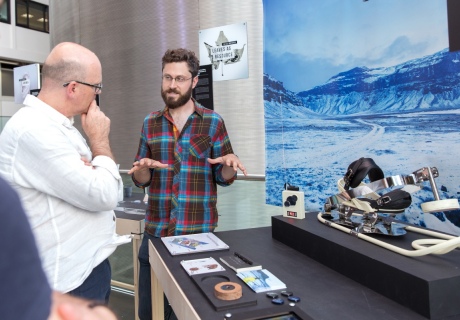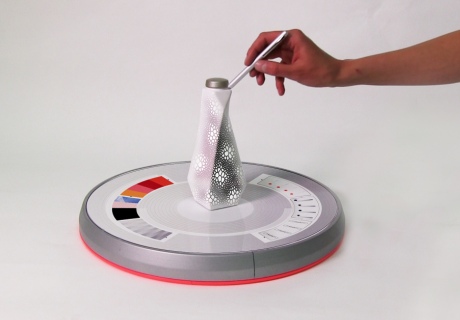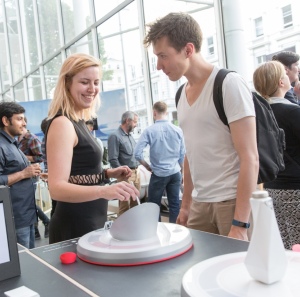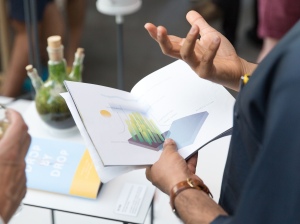
A Mammoth Step

From developments in artificial intelligence to a plant based water filtration system, the Dyson School Show celebrates the best of student design.
The projects on display include; The Reagiro, the world’s first manual everyday wheelchair with a built in steering system, and Personal Time Zones, an augmented reality system which allows people to create and collaborate through personalised time zones.
The show, featuring 50 different innovations developed by students on the Innovation Design Engineering (IDE) and Global Innovation Design (GID) courses, is the final display of work from the class of 2017. The courses are run jointly by Imperial’s Dyson School of Design Engineering and the Royal College of Art.
Professor Peter Childs, Head of the Dyson School of Design Engineering and Head of Programme for IDE, said: “Innovation Design Engineering has been running since 1980, and the course now has over 600 graduates. Four years ago we set up a new course, Global Innovation Design. It is such a privilege for Imperial to partner with the Royal College of Art for these two programmes.
“This year our students have been fantastic. They really do innovate on demand - we ask them to jump and they jump. We ask them to reform themselves and they reform themselves. They go beyond anything we ask of them and the results of this commitment are on show today.”
Professor Saeema Ahmed-Kristensen, Head of Programme for GID, said: “The stars of this show are the students. This year we’ve seen them taking on global challenges and global problems: everything from mental health to food shortages and providing design solutions.
“One of the big visions about GID is to provide a course where the provision we offer changes so it represents the students’ vision and their ideas as they study. We can see that this year that has really happened.”
The projects on display are an important window into the near-future of our society, demonstrating the kinds of products, systems and services we will be experiencing in the next decade.
Other projects on display this week include:
A Mammoth Step
Adam Joshua Bernstein’s uses his MammothStep snowshoes to challenge the status quo of sustainable design and environmentalism by proposing alternative consumer narratives - where products are designed to be restorative to the environment rather than extractive.
His project is designed to protect the arctic tundra, a strip of land across the northern hemisphere, stores more carbon dioxide than the whole of the earth’s atmosphere. As the globe continues to warm, the scientific community now fears that global warming could be compounded by a massive release of greenhouse gas from this ecosystem.
 Adam’s snowshoes mimic the impact of a mammoth, who previously roamed this land, and whose steps helped to compact snow, creating layer of thermal insulation which protected the permafrost of the arctic tundra.
Adam’s snowshoes mimic the impact of a mammoth, who previously roamed this land, and whose steps helped to compact snow, creating layer of thermal insulation which protected the permafrost of the arctic tundra.
Joshua said: “We need new consumer narratives in our culture to account for the needs of the local and global environment rather than the needs of the human user. These shoes are put to use on damaged ecosystems and their existence and use present a new model for a future human ecology.
“There is a long history of critical and speculative design at the RCA but less so on this programme. I wanted to use my project to offer a critical or social commentary about the approach design takes to environmental and sustainability issues.”
REACH
Maya Pindeus’ REACH is a platform that facilitates physical collaboration over distance. It builds a physical bridge across remote work environments and creates an interface for physical collaboration.

REACH
“My project is about rethinking the workplace. There are so many platforms right now for work based collaboration when you’re working on documents, but nothing for practical hands-on projects for designers like myself,” said Maya. “My project offers remote collaboration in a physical context - it’s like a Google Doc for physical products.”

Maya demonstrating REACH
A physical prototype is 3D scanned and then displayed as a 3D projection on in a remote virtual workspace. All collaborators can interact with the object by discussing and editing its physical properties through annotations, drawings and preview of materials. Every change done in one workplace is then visualized on the other workplace in real time.
Maya added: “I got the idea from my own work collaborating with colleagues abroad. Not being able to share physical work easily was a problem I found in my own projects and I wanted to focus on what a solution could look like.”
The show runs until 17:00 Friday 7 July at Imperial’s South Kensington Campus.
You can watch a Facebook Live video from Tuesday's opening event on our Facebook page.
Article text (excluding photos or graphics) available under an Attribution-NonCommercial-ShareAlike Creative Commons license.
Photos and graphics subject to third party copyright used with permission or © Imperial College London.
Reporters
Thomas Angus [Photographer]
Communications Division

Contact details
Tel: +44 (0)20 7594 2858
Email: t.angus@imperial.ac.uk
Show all stories by this author
Jon Narcross
Communications and Public Affairs

Contact details
Email: press.office@imperial.ac.uk
Show all stories by this author






Leave a comment
Your comment may be published, displaying your name as you provide it, unless you request otherwise. Your contact details will never be published.